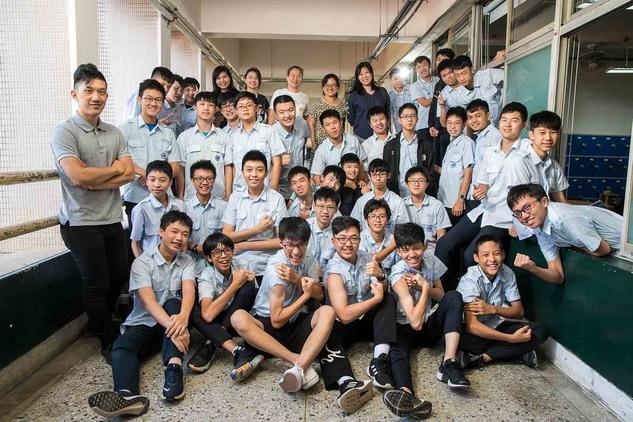HSNU: Providing Interdisciplinary Learning by Teaching Students to Care for the Oceans

Source:HSNU
How can we encourage students to take charge of their own education and acquire interdisciplinary skills? As citizens of a nation surrounded by water, the Affiliated Senior High School of National Taiwan Normal University chose “oceans” for its central theme. Starting with the faculty, the entire school is embarking on a journey of diversified exploration and interdisciplinary learning.
Views
HSNU: Providing Interdisciplinary Learning by Teaching Students to Care for the Oceans
By Ministry of EducationSponsored Content
Start from the Sea, Give Children the Gift of a Different Worldview
“In 2017, the entire faculty went through multiple conferences. We invited nearly sixty teachers to join the discussion. Together, we determined the core skills a student of HSNU should have. We also discussed if their courses should center around human rights, green energy, food and drink, the influence of technology, or the ocean,” says teacher Wang Ching-hua (王靖華), chair of the school’s course design committee. After much debate, “oceans” was chosen as the central topic of the mandatory courses in the Affiliated Senior High School of National Taiwan Normal University (HSNU).
This was despite the fact that HSNU sits squarely in the middle of Taipei City, far from any ocean. But the faculty agreed: “The ocean should not be seen as a barrier, but as an important thoroughfare that connects the world together. “In addition, the subjects that can be covered under the broader topic of “oceans” are many and varied. It helps teachers work with each other across disciplines to develop unique lessons. And of course, the teachers hoped to instill in students a different view of the world through marine education.
“Most importantly, the oceans cover seventy percent of the earth’s surface, and it has a major effect on the atmosphere. It affects climate change around the world and even the very future of humanity.” As a teacher of earth science, Wang brings a diversified viewpoint to the topic of oceans.
Interdisciplinary Education Starts with Teachers
Wang shares the way to successfully inject the topic of oceans into a broad range of different subjects. Not only should every key educator propose and elucidate an interdisciplinary topic, and also share their experience with colleagues on a regular basis, but “we also intentionally chose to hold our discussions in a busy area of the office, so we can attract the curiosity of other teachers. As time went by, it became easier to achieve success in our efforts.”
Besides encouraging everyone to build their skillsets, it is also important for teachers to review their own way of teaching. This was a tough assignment for many teachers.
“Even though teachers knew they had to grow past the old, unilateral, authoritative way of teaching, once class began, it was easy to unintentionally spend the entire session monologuing, without leaving any time for children to reply or express their own opinions,” says Wang. Eventually, teachers began reminding each other to give the students more room to express themselves and demonstrate their knowledge.
The way Wang sees it, because the teachers were fully aware that they must set aside their old way of thinking, it became possible to put the spirit of “AMT” into practice. What that means is to build problem-solving skills in children though the “acquisition” of knowledge, the “making” of meaning, and the “transfer” of learning.

Text Reading and Simulation Games Help the Learning Experience Take Root
As for course design, marine education at HSNU uses ocean-related literature and art, and lessons that build awareness of the ocean, to help students accumulate knowledge of the seas, which in turn develops their empathy for the marine environment.
Once, a student read “Fish Dream” (魚夢) by Lin Yao-de (林燿德) and “The Man with the Compound Eyes” (複眼人) by Wu Ming-yi (吳明益) in class. Afterwards, the student wrote an essay called “Lingering Dream About Becoming a Fish” in the feedback form. In the dream, the student turned into a fish and experienced how powerless a fish must feel about the changing ocean environment, as well as the grief of losing the familiar arms and legs of a human.
In order to help students understand the importance of ecological balance, courses such as “ocean consumerism” and “ocean pollution” make good use of simulation games promoted by the Taiwan Association for Marine Environmental Education (社團法人台灣海洋環境教育協會), such as “Fisher’s Glory” (漁人的榮耀). “Through the game, students discover that taking more for oneself meant leaving less for others. Through this experience, children appreciate the ‘coopetition’ that exists within ocean consumerism.”

But the main reason why the courses are popular with students is because of this: after the accumulation of knowledge and the enhancement of the experience through games, students are able to organically “produce” the knowledge through the Claim, Evidence, Reasoning (CER) model.
The CER model mainly encourages students to make a claim, provide evidence, and garner support. A student once wrote in the feedback form that this method helped him to learn how to integrate a large amount of information; it also taught him to approach a matter from many different angles when analyzing the situation.
In the face of the trend of globalization, HSNU uses marine education to inject environmental consciousness and global civic awareness in the children. More importantly, it uses a topic-centric course design to teach children to proactively discover questions and find new ways to solve problems.
Translated by Jack C.
Edited by Sharon Tseng
Content sponsored by Ministry of Education







